A compressor pedal affects the sound dynamics of the electric guitars. It enhances the sound of quieter notes and, conversely, makes the loud sounds quieter. The best compressor pedal is capable of creating a balanced sound and beefy tone.
The compression effect comes in handy when you need to emphasize the lead guitar tone on a clean channel (due to its ability to enhance each individual note of the chord). The compression pedals are widely used with electric and rhythm guitars. Also, they are used both at live performances and in recording studios. The compressor pedals are able to make even usual budget guitar sound more assertively and more sophisticated.
Despite the fact that the compression pedal may seem simple at first glance, it allows using such advanced techniques as chicken pickin’, sweep picking, hammer-on, pull-off, and tapping.
There are a lot of compressor pedals on the market, which makes it difficult to choose the appropriate one, particularly for beginners. Consequently, we offer you to take a look at our list of the best compressor pedals that can ease your choice. If you haven’t decided whether or not to purchase a pedal, our buyer’s guide may assist.
Compressor Pedal Reviews
Xotic SP
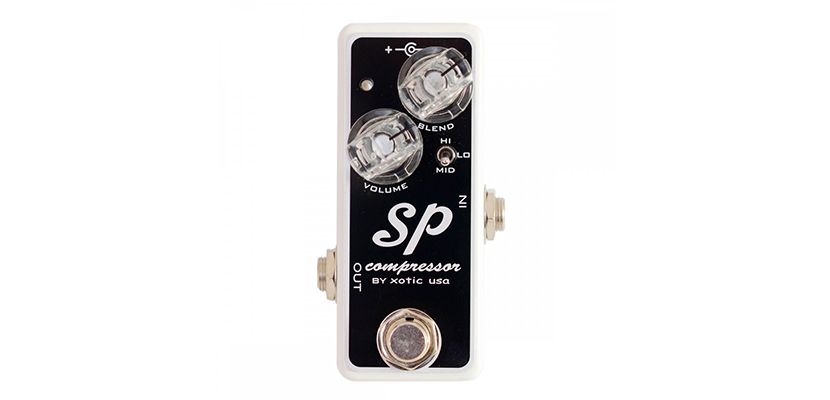
This Xotic compressor pedal is extremely compact and has a minimalistic interface. With 4 x 6 x 4 inches of size dimensions, it features only two control knobs (Volume and Blend) and 3-position attack sensitivity microswitch (Hi, Lo, Mid). There is also an LED indication that glows green when the pedal is activated.
Despite its small size, the pedal is also supplied with a true bypass so it’s completely disconnected from the circuit when you are not using it. The pedal also has a wide range of vintage and more modern tones thanks to the usage of the OTA technology. The pedal is very versatile, with a dry signal that can be increased up to 15 dB. Thanks to the attack control, the SP compressor is capable of removing the annoying tough attack while equalizing the sound.
Pros
- The Xotic SP is able to produce transparent sound.
- The pedal is supplied with a built-in battery.
- It’s great for clean sound as it doesn’t color the signal.
Cons
- It doesn’t provide a great effect on one tone.
- The pedal may chomp the rough edges of the fuzz a bit which may seem unpleasant for some users.
Video Xotic SP
Wampler Ego
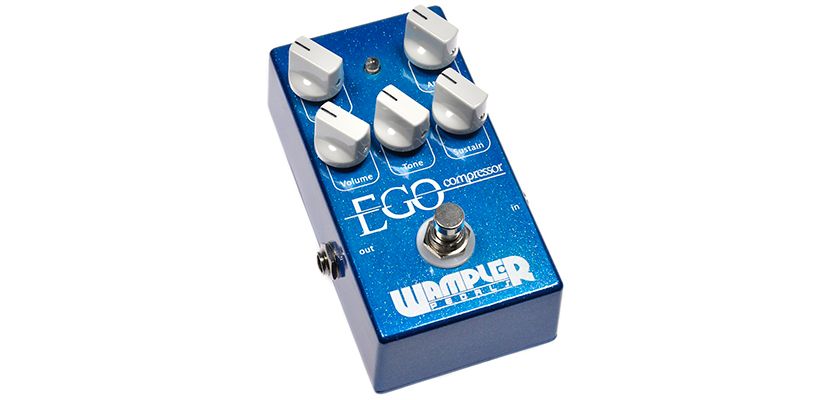
The Wampler Ego compressor has five control knobs, making it one of the most versatile versions. Despite this, the pedal remains compact (6 x 2 x 3 inches).
The Volume knob on this pedal provides plenty of volume so you can whether go farther than your input level or ensure the equal volume for both signals. The Sustain knob will let your notes go on for a very long time at its higher settings. However, remember that it also produces more noise. The Attack knob can gradually compress the signal at its slower settings. At quicker settings, it allows getting a noticeable pop-in. This knob also ensures the most classic country chicken pickin’ sound. The Tone knob adds extra sparkle and presence to the sound. The Blend knob mixes clean and compressed signals as even as possible.
Pros
- The pedal has highly durable relay switching for completely true bypass.
- Wampler’s guitar compressor pedal is completely handcrafted, ensuring superior build quality.а
- The high-grade film capacitors and resistors ensure high-quality sound and great response.
Cons
- The pedal comes without a battery.
- It may distort the sound of your music sometimes.
Wampler Mini Ego

The Wampler Mini Ego is a miniature version of the Wampler Ego Compressor (7 x 4 x 7 inches). Despite this, the pedal has five controls: three knobs for Blend, Sustain, and Volume, and two mini-toggle switches (for dark/bright Tone and slow/fast Attack). The pedal is also not deprived of true bypass so it keeps your signal unaffected.
This mini compressor pedal works well as a “always on” compressor because to its extensive range of settings and clean tone. Plus, it still can deliver a transparent performance and provides a great range of settings, from chicken pickin’ to the subtlest tones. The Blend knob allows getting enhanced, boosted, or slightly warmed signals. The Volume knob will let you set almost any desired amount of compression. The Sustain knob will maintain the signal within its compression threshold.
Pros
- The Mini Ego is manufactured with high-quality components made in the USA.
- The pedal allows having a parallel compression.
- It works great with any amplifier.
Cons
- The battery is not included in the kit.
- The pedal does get noisy at times.
- If it isn’t plugged in, its loud tone rapidly depletes the battery.
Video Wampler Mini Ego
Boss CS-3
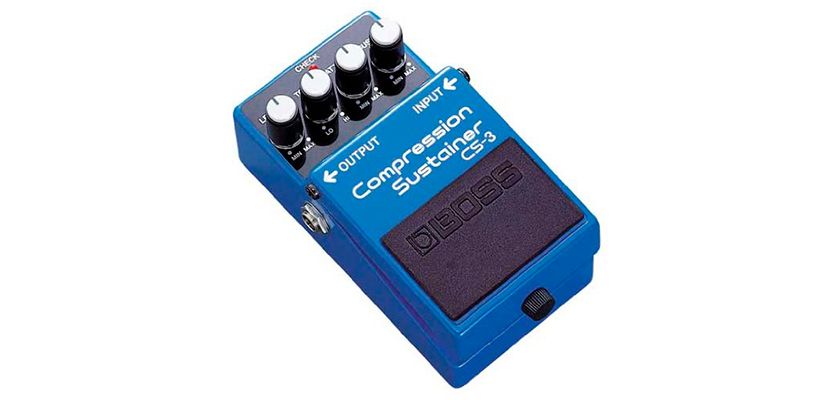
This Boss compressor pedal goes in a high-quality case made of a special metal alloy, thanks to which the pedal gets an additional shielding. It can act as both compressor and sustainer pedal and is designed for guitarists and bassists.
The pedal has four control knobs (Level, Attack, Tone, and Sustain) that allow shaping the sound characteristics with increased accuracy. It goes in quite compact housing (4 x 3 x 6 inches). The pedal has an LED indicator (Check) which activates the red light as you press the footswitch. It also indicates the battery level, becoming dimmer when the battery starts to drain.
The Boss CS3 is a pedal with an active circuit that compresses the sound of an electric or bass guitar, significantly increasing the note duration thanks to the Sustain knob. At the same time, it has no effect on the timbre of your instrument’s sound.
The pedal can be powered in two ways: by power adapter (DC 9V, AC Adapter) or a battery (9V, 6F22/9 V), which can be found in the kit.
Pros
- The pedal’s knobs rotate very softly and smoothly.
- The Boss CS3 allows doing both mild and very squashed compression.
Cons
- The pedal produces some hiss.
- The sound is not fully transparent.
Video Boss CS-3
MXR M102 Dyna Comp
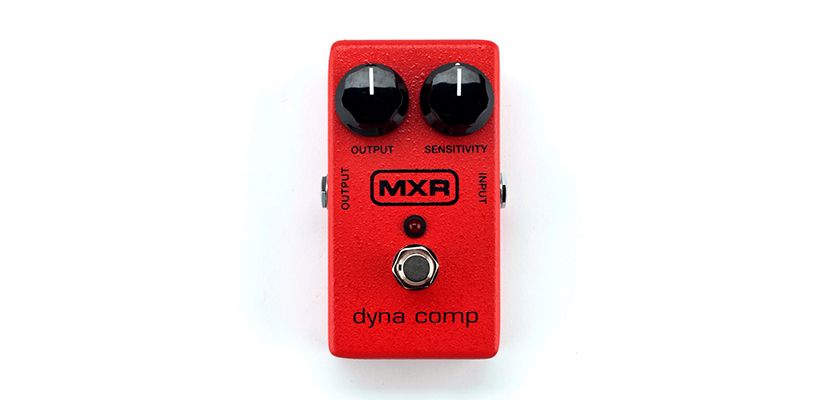
This bass compressor pedal from MXR is one of the simplest models on the market. It has only two knobs: the Output knob for volume control and Sensitivity knob to control the ratio, and a hardwire bypass configuration. The pedal has a fixed attack and release time of 5 milliseconds.
One of the most significant aspects of this compressor is that it colors tone, which may not be appropriate for everyone. And while it may not be fully transparent, it still designed for professional use. The pedal endows the sound with authentic vintage flavor. This device can produce the percussive, clicky sound from 80’s pop music or a mellow sustain for lead work.
The MXR compressor pedal goes in a red vintage housing and has 5.8 x 4.5 x 2.8 inches of size dimensions. It requires either a 9V battery or a Dunlop AC power supply to run (not included).
Pros
- The pedal has maximum compression of 36dB which means that you can go for some extreme effects.
- The pedal has the convenient red LED on/off indicator in the middle of the front panel.
- The MXR M102 uses a signal-limiting processor so the output signal stays constant.
Cons
- The volume boost is quite limited.
- The output control is too sensitive, making fine adjustments impossible.
Video MXR M102 Dyna Comp
MOOER Yellow Comp
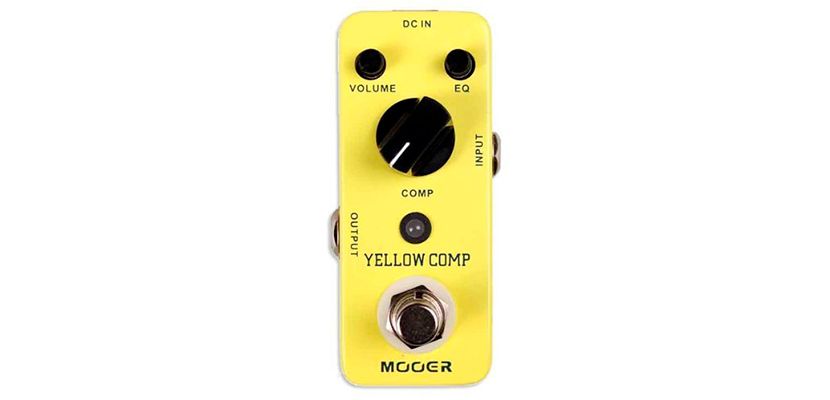
This pedal from MOOER is of a classic optical type which is suitable for acoustic guitar compression. It’s so small in size that can fit it in your pocket (1.8 x 4.2 x 2.2 inches) but has three controls (Volume, EQ and Comp), true bypass, and LED off/on indicator. Despite its tiny size, the pedal still remains universal: the controls allow adjusting volume, compression ratio, and brightness. This way, you can squish and click your guitar signal whatever you want.
This optical compressor pedal doesn’t have any added coloration and does nothing to your tone. This way, the pedal is fully transparent which is great for beefing up your tone but not very good for country style. Its low-noise operation is perfectly suitable to smooth out your rhythm playing, add long sustain to your solos, or simply boost your signal.
Pros
- The pedal is housed in a complete metal enclosure.
- The MOOER Yellow Comp performs compression without volume loss.
Cons
- The pedal requires a 9V DC power supply which is not included in the kit.
- You can’t adjust the Release and Attack.
- The pedal can’t be powered by the battery.
Video MOOER Yellow Comp
TC Electronic Hypergravity
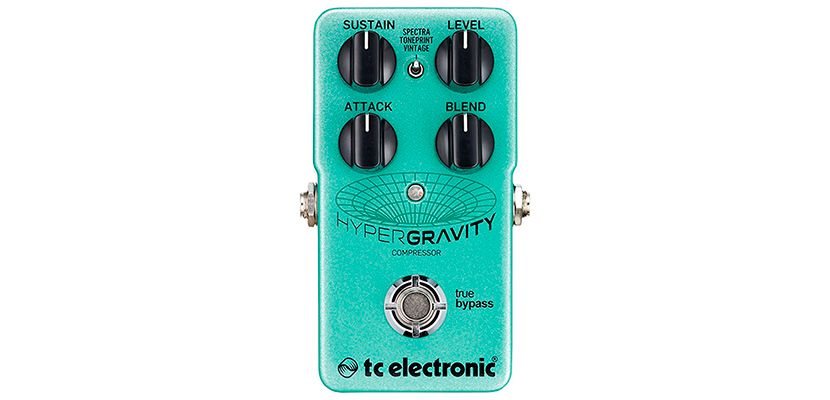
The TC hypergravity is a studio-quality multiband compressor pedal supplied with four control knobs (Sustain, Attack, Level, and Blend). Additionally, it also features a Vintage Mode so you can reproduce the classic compression and imitate the sound of old classic stompbox compressors. The True/Buffered Bypass switch guarantees optimal tonal integrity and zero loss of tone. Due to the synchronization with the TonePrint Editor, the pedal gives you control over all parameters via your computer or phone. It also gives almost endless compression combinations.
The MD3 multiband algorithm ensures perfectly tailored compression for highs, mids, and lows. Additionally, it also provides the ultra-transparency of sound. This way, you can go from subtle shimmering sound to the thickest effects without compromising your original tone.
Despite its extensive capabilities, the pedal is compact in size (5 x 3 x 4 inches).
Pros
- The pedal is perfectly suitable for percussive country tones.
- This pedal has tough and rugged construction.
- The Analog-Dry-Through allows the dry sound to pass through whether the pedal is on or off.
Cons
- You may have to experiment with this pedal a lot to achieve the right tone.
- Most parameters can only be edited through the TonePrint Editor.
Video TC Electronic Hypergravity
Walrus Audio Deep Six
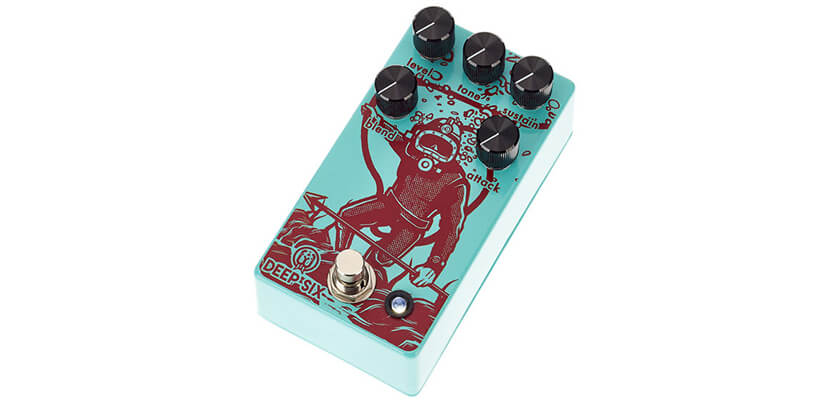
The Deep Six compressor is quite a multifunctional model that goes with four control knobs — Level, Sustain, Blend, and Attack which contribute to great versatility. For example, the Blend and Attack controls allow using the pedal along with active pickups or humbuckers. The Blend knob also allows using high output instruments while being able to detect almost any distortion.
You don’t have to worry about polarity with this pedal since it has a polarity correcting circuit. The internal voltage which is doubled to 18 volts. The pedal can be powered from both 9V battery and DC Supply (not included). With 8 x 4 x 8 inches of size dimensions, it’s quite a big model.
Pros
- The pedal maintains a typical current draw of 8.9mA for extended battery life.
- This pedal can give an extra boost to your leads.
- The Deep Six provides the evenest rhythm.
Cons
- Pedal does not indicate whether or not compression is applied.
- It’s susceptible to background noise levels.
Video Walrus Audio Deep Six
Buyer’s Guide
Do You Need A Compressor Pedal?
If you have never been trying to use a compressor pedal, you may feel confused about whether you really need it or not. So let’s run through the most popular applications, specs, and the possibilities it can give.
So, how the compression pedal can be helpful? This device can greatly simplify the creation of artificial flageolets. Trills, tapping, legato are also easier to perform with the guitar compressor turned on since the sound becomes evener. Some guitarists also use a compressor with a clear sound in order to equalize the sound dynamics.
Even if the compressor pedal features a lot of parameters, changing each of them won’t lead to drastic changes. This way, the result of sound processing performed by a compressor pedal is soft and barely noticeable. For instance, you may use it to just make your guitar sound louder and more expressive.
The compressor pedal is almost indispensable for rhythm parts in funk and blues. It can clearly stand out the guitar part in the song. Plus, it can fit the sound in the normal volume, eliminate the signal failures, and make your part sound more distinctly. When it comes to rock music, the pedal allows getting more sustain without the need to use too much distortion.
In the case, if you are playing solo that is slow and variable, then most likely you will not need a compressor.
So, the compression pedal gives the opportunity to diversify your sound and discover new features of your instrument. Most of the music directions (especially popular modern music), except for classical and some jazz movements, are directly related to the usage of the compression effect. Therefore it’s useful for recording, mixing, songwriting, etc.
How to Choose The Compressor Pedal?
When choosing the best compressor pedal, you need to pay special attention to some factors. For example, if you need a pedal that provides increased convenience, you should look for a device with easy operation. Such a pedal usually has a small number of controls and is easy in operation.
One of the most essential considerations when choosing a compressor pedal is an interface. The devices with a knob that allows switching between different modes makes the pedal control simpler. The pedal with minimal tone coloration will help you maintain the authenticity of your sound. It’s also recommendable to choose the pedal that features a true bypass to ensure cleaner sound. Or, if you need to boost your signal, go for the unit with buffered output. There are also a lot of models that can offer to switch between both of these features.
If you consider the compression effect as one of the most important ones in your signal chain, check if the pedal can offer several kinds of compression.
The construction of the pedal is also important. A lightweight and compact unit is easier to store and transport. It also will fit in your pedalboard with ease. The pedal with an LED indicator also gives more advantages and convenience since it shows the battery level, indicates an on/off status, etc.
Parameter Controls
Before getting a compressor pedal, it’s necessary to be aware of the parameters it can offer. It’s also worth to note that the pedal with a minimal set of control knobs shouldn’t be considered as the worse one. There are a lot of superior models that have only two controls.
Threshold
It determines the sound level where the compressor begins to apply to the signal. If the Threshold level is too high, the signal won’t be subjected to any processing. If, on the contrary, the Threshold level is too low, then the entire signal will be compressed.
Ratio
It determines the intensity of signal attenuation. Simply put, it allows controlling how much volume is reduced above the Threshold.
Attack
It’s the time after which the compressor activates. A long attack time allows applying the compression without affecting fast, transient signals. A short attack time will let you catch the instant notes and skip medium-duration sounds but will attenuate the high recording frequencies.
Release
It’s the time during which the signal becomes uncompressed. As usual, the longer the release time is, the more natural is the sound.
Make-Up Gain
It allows raising the final compression to the required level. It’s the amplification stage between the input and output signals which provides the required signal level for recording and mixing.
Headroom
It determines the dynamic range of the signal.
Knee
It determines how the signal will be processed after it exceeds the Threshold. The Hard Knee ensures a quick transition from the unprocessed signal to the processed one. The Soft Knee implies a smoother transition.
Note that each parameter works differently on each unit. From pedal to pedal, it can be more or less effective, allow reaching a variety of different effects or perform only the basic function.
Types of Compression
There are five main types of compression:
Optical
It uses an opto-isolation, made of a light bulb or an LED and a photocell. The light source blinks brighter or dimmer, depending on the level of the input signal. The photocell reads various brightness indicators and changes the gain level in accordance with them. The optical compressors usually have natural sounding of the Attack and Release, but they are also quite slow. Consequently, the optical compressors are more frequently used with vocals, bass, and electric guitars.
VCA
It uses the microcircuits thanks to which you can adjust the Attack and Release very accurately. Usually, such type of compressors don’t give out natural sound and can damp high frequencies at high compression levels.
Valve
It’s based on the circuits with a tube or tubes. As usual, such compressors have a warm and creamy tone. However, they don’t allow adjusting the depth of the compression. They also have the smallest dynamic range in comparison with other compression types.
FET
It uses the transistor as a control element and has faster the Attack mode and cleaner sound but rather a limited dynamic range. Therefore, the FET compressors often distort the sound at high signal levels.
Multi-Band
It compresses the signal differently at different frequencies. In other words, the multi-band compressors allow compressing high or low frequencies in different ways. The signal divides by frequency with the help of several filters at the input. After, different compression is applied for each divided signal, and then everything is mixed back at the output.
Using a Compressor Pedal With Other Effects
It’s not always easy to determine the pedal’s location in the signal chain. However, it’s one of the most important issues since you won’t get satisfactory results from any pedal if it is not placed properly.
Being located at the beginning of a chain, the pedal will produce minimal noise. However, the effects located after the compressor pedal won’t be subjected to compression. Being placed at the end, it will control the volume of the signal after all the other effects. However, in this case, the compression pedal will make the noise produced by the other pedals more noticeable. Never put the compressor after an overdrive effect or into an open loop of effects on a combo amplifier or you risk getting an excessively noisy sound.
In fact, the pedal’s placement depends not only on your personal preferences, music genre, and role in the band. It also depends on what you are trying to get out of your pedal, so it’s better to experiment around with its placement and you will be able to change your tone drastically.

Hi everyone! I’m Thomas Moody, also known as Guitarzan.
